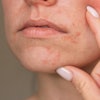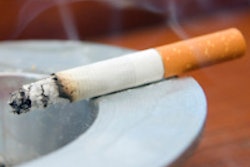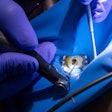
Children exposed to tobacco smoke at 4 months had an almost twofold increase in the risk of caries in their deciduous teeth in a new study from Japan. The findings support increasing public health and clinical interventions to limit exposure to secondhand smoke, according to the researchers.
In this study, researchers led by Koji Kawakami, MD, PhD, from Kyoto University analyzed the records of nearly 77,000 children born in Kobe City, Japan, between 2004 and 2014 from birth until 3 years old.
"The associations between secondhand smoke and risk of caries would support extending public health and clinical interventions to reduce secondhand smoke," the authors wrote. "For example, education on the harm of secondhand smoke might increase if dentists became aware of the risk of caries due to secondhand smoke as well as tobacco consumption of their clients" (BMJ, October 21, 2015).
Secondhand smoke
The global prevalence of those exposed to secondhand smoke is estimated to be 40% of children and more than 30% of nonsmokers. Earlier cross-sectional studies have suggested a link between secondhand smoke and caries in both deciduous and permanent teeth, the study authors noted.
“Education on the harm of secondhand smoke might increase if dentists became aware of the risk of caries due to secondhand smoke as well as tobacco consumption of their clients.”
Secondhand smoke's adverse effects, the authors wrote, include the following:
- Inflammation of the oral membrane and impaired salivary gland function
- A decrease in serum vitamin C levels
- Immune dysfunction
Children exposed to passive smoking also have lower salivary IgA levels and higher levels of sialic acid with higher activity. Sialic acid enhances agglutination of Streptococcus mutans, which leads to the formation of dental plaque and caries, the authors noted.
In addition to the direct effects of secondhand smoke, inhibition of the morphology and mineralization of dental hard tissue in the offspring of rats exposed to passive smoking also have been reported.
Increased risk of caries
The Japanese study included 76,920 children, who had health checkups at birth and 4, 9, and 18 months, as well as at 3 years. Dentists assessed the oral conditions of the children at 18 months and 3 years through a visual exam. Almost 92% of the children surveyed had a dental exam at 3 years.
For this study, secondhand smoke was defined as maternal smoking during pregnancy, smoking in the household when the infant was age 4 months, and exposure to tobacco smoke at age 4 months.
Information on lifestyle factors was based on parent-reported questionnaires, which the mothers were required to fill out at every health checkup. The child's exposure to secondhand smoke from pregnancy to age 3 was assessed as maternal smoking during pregnancy, daily number of cigarettes smoked during pregnancy, presence of smokers in the household during pregnancy, smoking status of parents and family members when the infant was 4 months of age, and presence of smokers in the family at 9 months, 18 months, and 3 years.
The researchers found 12,729 report cases of dental caries, with 12,579 related to decayed teeth. The mean DMF index (the number of decayed, missing, or filled teeth) was 0.06 at age 18 months and 0.61 at 3 years.
The unadjusted three-year risk of caries reported in the study were 18% in total and 14% for infants in households where no family members smoked, compared with 20% when family members smoked away from infants and 27.6% when infants were exposed to tobacco smoke at age 4 months.
Children with family members who smoked had significantly more decayed, missing, or filled teeth than those with no smokers in the family, according to the study. The mean DMF index at 18 months was 0.03 with no family members who smoked and 0.11 (p < 0.01) with infants exposed to tobacco smoke at age 4 months. At age 3, the mean DMF index was 0.44 for the children with no smokers in the family and 1.07 for those exposed to smoke at age 4 months.
The researchers also noted similar associations at different sites (mandibular or maxillary teeth, anterior teeth, or molars).
In addition, they found differences in behavior patterns between those exposed to and not exposed to smoking, such as lack of toothbrushing and irregular consumption of sweets, the authors noted. Children at 4 months old with family members who smoked had their teeth brushed less frequently, they reported. And while the frequency of eating sweets was similar among the groups, exposure to smoke was associated with higher proportions of bottle feeding and drinking juice every day.
Finally, the researchers found that the effect of maternal smoking during pregnancy was not statistically significant in regard to an increased risk of caries.
Further investigations
The authors listed possible limitations in the study:
- They cautioned that the results may not be generally applicable to populations with different environmental and lifestyle factors, and they give the examples of community water fluoridation (not done in Japan since 1972) and different levels of sugar intake in different countries. Interestingly, more than 99% of the children in the study had received fluoride varnish at 18 months.
- Information on smoking status was obtained by questionnaires completed by mothers not by biomarkers.
- In an epidemiological study, it is difficult to separate the effects of secondhand smoke from those of thirdhand smoke (defined by the authors as the residual contamination from tobacco smoke that remains on a variety of indoor surfaces).
- The oral conditions were not necessarily assessed by pediatric dentists.
As this was an observational study rather than a randomized trial, the authors also noted it is impossible to establish causality.
They concluded that more research is needed.
"Further investigation is necessary to conclude whether a smoking prevention program would reduce the risks of caries, since the size of effects of secondhand smoke was not large," the authors concluded.



















